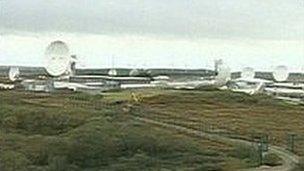Goonhilly at 'forefront of space exploration'
- Published

Goonhilly was once the world's largest earth station with more than 60 dishes
Part of the telecommunications site at Goonhilly Downs in Cornwall is to be sold to create a space science centre.
The deal includes upgrading satellite dishes for "deep space communication with spacecraft missions".
A link with the University of Oxford will mean new radio astronomy work on the origins of the universe.
Ian Jones, who heads the new company, Goonhilly Earth Station Limited, said their aim was to support "missions to the Moon, Mars and beyond".
Under the deal, GES Ltd will take a three-year lease on most of the antennae at the BT-owned site with an option to buy the entire complex in the future.
Prof Steve Rawlings, Oxford University professor of astrophysics, said the radio astronomy projects would examine "the biggest unsolved problems like dark energy and quantum gravity".
Skilled jobs
The site will link Goonhilly's telescopes to global radio astronomy networks, eventually including the 1.5bn euro Square Kilometre Array (SKA) - a radio telescope which will have a dish size equal to one square kilometre.
It is also hoped that the investment by companies such as defence technology firm QinetiQ and the UK Space Agency would provide "an important source for skilled jobs in Cornwall", said Mr Jones.
Under the plans, the former visitor centre will also be upgraded to transform it into "an outreach centre promoting space and space science for visitors, including local residents and schools", said Mr Jones.
The project, which has been three years in the making, has been welcomed by St Ives MP Andrew George but he said government support was crucial.
Goonhilly opened in the 1960s and was once the world's largest earth station with 60 operational satellite dishes which attracted up to 80,000 visiitors a year.